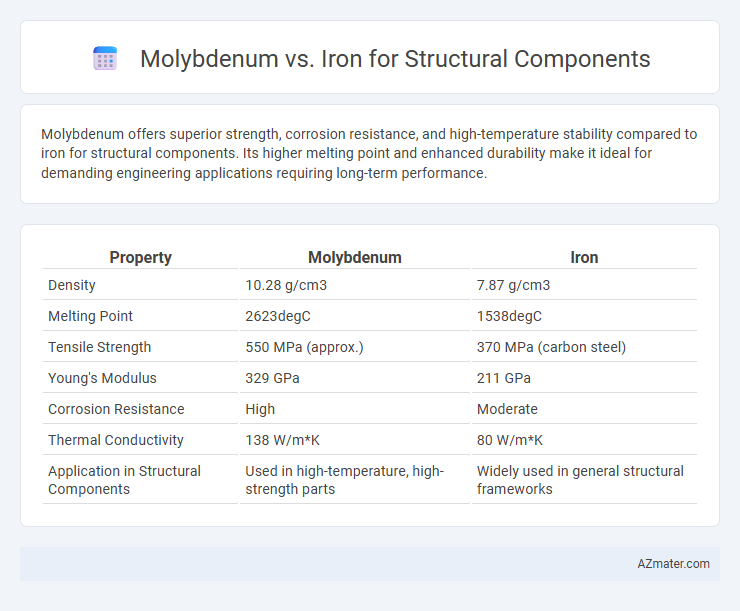Molybdenum offers superior strength, corrosion resistance, and high-temperature stability compared to iron for structural components. Its higher melting point and enhanced durability make it ideal for demanding engineering applications requiring long-term performance.
Table of Comparison
| Property | Molybdenum | Iron |
|---|---|---|
| Density | 10.28 g/cm3 | 7.87 g/cm3 |
| Melting Point | 2623degC | 1538degC |
| Tensile Strength | 550 MPa (approx.) | 370 MPa (carbon steel) |
| Young's Modulus | 329 GPa | 211 GPa |
| Corrosion Resistance | High | Moderate |
| Thermal Conductivity | 138 W/m*K | 80 W/m*K |
| Application in Structural Components | Used in high-temperature, high-strength parts | Widely used in general structural frameworks |
Introduction to Structural Materials: Molybdenum vs Iron
Molybdenum offers superior strength-to-weight ratio and high-temperature resistance compared to iron, making it ideal for advanced structural applications. Iron, primarily used in steel alloys, provides excellent toughness and cost-efficiency for conventional construction purposes. The choice between molybdenum and iron depends on performance requirements, environmental conditions, and budget constraints.
Chemical and Physical Properties Comparison
Molybdenum exhibits a higher melting point of 2623degC compared to iron's 1538degC, making it more suitable for high-temperature structural components. Chemically, molybdenum is more resistant to corrosion and oxidation, which enhances durability in harsh environments, while iron is prone to rust and requires protective coatings. Physically, molybdenum offers greater tensile strength and stiffness, with a density of 10.28 g/cm3 versus iron's 7.87 g/cm3, affecting component weight and mechanical performance.
Mechanical Strength and Durability
Molybdenum offers superior mechanical strength and excellent high-temperature durability compared to iron, making it ideal for structural components exposed to extreme conditions. Its high melting point (2,623degC) and resistance to wear and corrosion significantly enhance long-term performance in demanding environments. In contrast, iron, with lower tensile strength and lower corrosion resistance, is more prone to mechanical degradation under stress and harsh conditions.
Corrosion Resistance and Environmental Performance
Molybdenum exhibits superior corrosion resistance compared to iron due to its ability to form stable, protective oxide layers that prevent further oxidation and degradation. In harsh environments, such as those involving acids or seawater, molybdenum alloys demonstrate enhanced durability and longer service life than typical iron-based materials. This improved corrosion resistance directly contributes to better environmental performance by reducing maintenance frequency and the risk of structural failure.
Weight Considerations and Structural Efficiency
Molybdenum features a lower density of approximately 10.2 g/cm3 compared to iron's 7.87 g/cm3, influencing weight considerations in structural applications. Despite its higher density, molybdenum offers superior strength-to-weight ratios and higher melting points, enhancing structural efficiency under high-stress and high-temperature conditions. Iron's lower cost and ease of fabrication make it practical for weight-sensitive designs where extreme performance is not critical.
Cost-Effectiveness and Availability
Molybdenum offers superior strength and corrosion resistance for structural components but comes at a significantly higher cost compared to iron, making it less cost-effective for large-scale applications. Iron, particularly in its steel alloy forms, remains highly affordable and widely available globally, ensuring consistent supply and lower material costs. The choice between molybdenum and iron largely depends on whether enhanced performance justifies the premium price, with iron favored for budget-conscious and mass production needs.
Fabrication and Weldability
Molybdenum offers superior high-temperature strength and corrosion resistance compared to iron, making it ideal for demanding structural components in extreme environments. Fabrication of molybdenum requires specialized equipment due to its high melting point and brittleness, whereas iron offers easier machining and forming with conventional tools. Weldability of iron is generally better, with standard welding processes applicable, while molybdenum's welding demands controlled atmospheres and precise techniques to avoid cracking and embrittlement.
Common Applications in Construction and Engineering
Molybdenum is widely used in construction and engineering for its high strength, corrosion resistance, and ability to improve the durability of steel alloys in structural components. Iron, primarily in the form of steel, remains the dominant material due to its cost-effectiveness, versatility, and excellent mechanical properties in load-bearing frameworks and reinforcement bars. Common applications leverage molybdenum-enhanced steel in bridges, skyscrapers, and heavy-duty industrial structures, while pure iron or basic steel is standard for residential buildings and general infrastructure projects.
Sustainability and Lifecycle Assessment
Molybdenum exhibits superior corrosion resistance and high-temperature strength compared to iron, enhancing the durability and lifecycle of structural components. Its ability to withstand extreme environmental conditions reduces maintenance frequency and material replacement, contributing to sustainability through lower resource consumption. Lifecycle assessments show that although molybdenum's initial extraction has a higher environmental footprint, its extended service life and recyclability lead to a reduced overall environmental impact compared to iron-based components.
Conclusion: Choosing the Right Material for Structural Components
Molybdenum offers superior strength-to-weight ratio and excellent high-temperature stability compared to iron, making it ideal for extreme environments and advanced structural applications. Iron remains cost-effective and widely available with good tensile strength, suitable for general construction where high temperature resistance is not critical. Selecting molybdenum or iron depends on balancing performance requirements such as thermal resistance, tensile strength, and budget constraints for optimized structural component design.

Infographic: Molybdenum vs Iron for Structural Component
 azmater.com
azmater.com